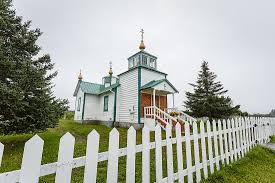Religion en Alaska: How Faith Shapes Life in the Last Frontier

Have you ever wondered what role religion plays in a place as remote and rugged as Alaska? This northernmost state is known for its icy landscapes, rich Indigenous culture, and adventurous spirit. Yet, behind the mountains and glaciers lies a diverse spiritual life that connects communities and preserves traditions. Exploring religion en Alaska is like opening a window into history, identity, and resilience.
The Unique Setting of Religion in Alaska
Alaska is not like any other state. Its vast size, isolated villages, and extreme weather create challenges that directly influence how faith communities function. While in larger U.S. cities people can attend services at several nearby churches or temples, in Alaska many towns may have only one place of worship.
Because of this, religious communities often play more than just a spiritual role. They become centers of social life, support, and cultural preservation. Faith in Alaska is not just about belief, it is also about survival and community.
Indigenous Spiritual Traditions
Before missionaries arrived, Alaska Native peoples practiced rich spiritual traditions deeply tied to nature. Many Indigenous groups believed that animals, rivers, and mountains carried spirits. Rituals and storytelling helped maintain harmony between humans and the natural world.
For example, the Yup’ik and Inupiat communities practiced ceremonies to honor animals that provided food. The Tlingit people integrated art and storytelling into their spiritual practices. These traditions continue today, often blended with Christianity or preserved through cultural revival movements.
The Arrival of Russian Orthodoxy
When Russian explorers and traders reached Alaska in the 18th century, they brought the Russian Orthodox Church with them. This faith took root, especially among Alaska Native communities in coastal areas.
What made Russian Orthodoxy unique in Alaska was its willingness to adapt. Priests translated prayers into Indigenous languages and respected local traditions. As a result, Russian Orthodoxy became deeply woven into the cultural identity of many Native groups. To this day, colorful Orthodox churches with onion-shaped domes can be found in villages across the state.
Protestant Missions and American Influence
After the United States purchased Alaska from Russia in 1867, Protestant missionaries arrived in large numbers. They introduced schools, hospitals, and churches, shaping education and healthcare in remote communities.
These missions had a lasting impact. While they provided valuable services, they also attempted to replace Native traditions with Western religious practices. Many Alaska Natives faced pressure to abandon their languages and spiritual customs. Today, however, there is a renewed effort to honor Indigenous traditions alongside Christian practices.
Catholic Presence in Alaska
The Catholic Church also played a significant role in Alaska’s history. Missionaries traveled by dog sled and boat to reach isolated villages. Their efforts built schools and orphanages, which became central to community life.
Catholicism remains strong in Alaska today, especially in areas with large Native populations. Parishes often blend traditional Catholic rituals with elements of local culture, creating a uniquely Alaskan expression of faith.
Religion as a Community Anchor
In Alaska, religion is more than just worship. Churches and other faith organizations often serve as gathering places, food banks, and centers for mutual support. In remote towns, pastors, priests, and elders may also act as community leaders.
When winter storms cut off transportation or power, religious groups often organize relief efforts. This sense of shared responsibility highlights how spiritual life in Alaska is tightly linked with survival and resilience.
The Diversity of Faith in Modern Alaska
Today, Alaska is home to a wide variety of religions. Alongside Russian Orthodoxy, Catholicism, and Protestantism, you will also find Buddhism, Islam, Judaism, and newer spiritual movements.
- Orthodox Christianity remains one of the strongest traditions, especially in Native villages.
- Evangelical churches are popular in urban centers like Anchorage and Fairbanks.
- Buddhism has grown among Asian communities and through spiritual seekers.
- Islam has a small but growing presence, with mosques serving immigrant families.
- Judaism is represented by small but active congregations, mainly in Anchorage.
This diversity reflects Alaska’s role as a crossroads of cultures, where people from around the world come to work, study, or explore.
How Geography Shapes Religious Practice
The unique geography of Alaska creates both challenges and opportunities for religious life. Vast distances mean that some communities only see a priest or minister a few times a year. In those cases, lay leaders often guide services and keep traditions alive.
At the same time, the breathtaking natural environment inspires deep spiritual reflection. Many Alaskans, regardless of faith, see their connection to the land as sacred. The Northern Lights, endless forests, and mighty rivers become reminders of something greater than human existence.
Celebrations and Traditions
Religion in Alaska is not just about weekly services, it is also about annual celebrations. For example:
- Russian Orthodox Christmas is celebrated in January, with traditional songs, processions, and feasts.
- Potlatch ceremonies among Alaska Natives blend cultural and spiritual elements, reinforcing community bonds.
- Catholic festivals often include local music, dances, and foods unique to Alaska.
These celebrations keep traditions alive while also bringing joy and togetherness.
The Role of Religion in Social Issues
Faith communities in Alaska are deeply involved in addressing social challenges. Issues like poverty, addiction, and mental health are significant in many areas. Churches and faith-based organizations often provide counseling, rehabilitation programs, and shelters.
In addition, many religious groups advocate for environmental protection. Since Alaska’s economy depends heavily on natural resources, faith leaders often emphasize stewardship of the land and respect for creation.
Blending Old and New Beliefs
One of the most fascinating aspects of religion en Alaska is the blending of Indigenous traditions with Christianity. Many Alaska Natives attend church on Sundays while still honoring ancestral practices. This dual identity reflects resilience and respect for heritage.
For example, some ceremonies may open with Christian prayers and continue with traditional songs or dances. This blending shows how faith adapts to people’s lives rather than erasing their history.
Religion and Identity in Alaska
For many people in Alaska, religion is not just personal but also cultural. It connects individuals to their ancestors, neighbors, and environment. Whether it is an Orthodox cross on a village church or a Native drum used in ceremony, faith symbols remind people of who they are and where they belong.
Future of Religion in Alaska
Looking ahead, religion in Alaska will likely continue to evolve. Urban areas may see more diversity with growing immigrant communities, while rural villages will hold onto Orthodox and Catholic traditions. Younger generations may explore spirituality in new ways, blending modern ideas with traditional wisdom.
What will remain constant, however, is the importance of faith as a source of strength and identity in the Last Frontier.
Conclusion: A Spiritual Landscape Like No Other
So, what makes religion en Alaska so unique? It is the way faith adapts to the land, the people, and the challenges of life in such a remote place. From Indigenous traditions to Russian Orthodoxy, from Catholic parishes to modern faith communities, Alaska’s spiritual life is as diverse as its landscapes.
In the end, religion here is about more than belief. It is about community, resilience, and connection to the natural world. And just like the mountains and glaciers, it stands tall as a defining part of Alaska’s identity. religion en alaska



